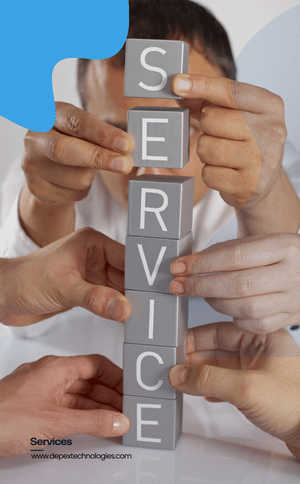Multi-Agent AI System Development: A Complete Guide
In the evolving landscape of artificial intelligence, multi-agent AI system development stands out as a transformative approach for solving complex, distributed, and real-time problems. Businesses across the globe are leveraging multi-agent systems (MAS) to enable sophisticated automation, adaptive decision-making, and collaborative intelligence—paving the way for next-generation enterprise applications.
Whether it’s in finance, healthcare, logistics, or smart cities, the power of multiple AI agents working together is reshaping what’s possible with automation. In this comprehensive guide, we’ll explore what multi-agent AI systems are, how they work, their benefits and use cases, essential development steps, challenges, and why partnering with Depex Technologies ensures your success in this advanced field.
What is a Multi-Agent AI System?
A multi-agent AI system is a software ecosystem where two or more autonomous entities—called agents—interact or work together to achieve specific goals. Each agent is capable of making decisions, communicating, and taking actions independently, but often, agents coordinate with others to optimize overall outcomes.
Think of it like a team of specialized experts working together: instead of a single AI handling every task, you have a group of intelligent agents, each with a unique role, collaborating or competing within an environment to solve complex problems.
Key Benefits of Multi-Agent System Development
The development of multi-agent AI systems brings powerful advantages for enterprises, including:
- Scalability: Easily manage and expand complex systems by adding or removing agents without redesigning the whole system.
- Robustness: Failure of one agent doesn’t cripple the entire system. Agents can compensate for each other, ensuring high availability.
- Flexibility: Adapt to dynamic, changing environments quickly through distributed intelligence.
- Distributed Problem Solving: Divide complex tasks into manageable sub-tasks, letting agents solve parts independently and share results.
- Collaboration and Competition: Enable both cooperation and competition among agents for optimized solutions, boosting efficiency.
- Real-time Decision-Making: Respond rapidly to real-world changes using decentralized control.
How Do Multi-Agent AI Systems Work?
At the heart of multi-agent AI system development lies the concept of autonomous agents interacting in a shared environment. Here’s how it works:
- Autonomy: Each agent can operate without direct human intervention, making decisions based on local information and predefined rules or AI models.
- Communication: Agents share information using protocols, enabling collective problem-solving or negotiation.
- Coordination: Agents may cooperate (work towards a shared goal), compete (optimize for their own outcome), or even negotiate to resolve conflicts.
- Learning: Modern systems allow agents to use machine learning and reinforcement learning to improve over time.
Example: In a smart logistics network, some agents/Catboat monitor traffic, others track packages, and some optimize delivery routes—together, they dynamically adapt to changes, ensuring fast and efficient deliveries.
Core Components of Multi-Agent Systems
To develop a robust multi-agent AI system, certain foundational components are essential:
- Agents: The core decision-making entities, each with sensors (to perceive) and actuators (to act).
- Environment: The domain or context where agents operate (physical world, simulated environment, digital system).
- Communication Protocols: Standardized ways for agents to exchange information (e.g., FIPA-ACL, REST APIs).
- Coordination Mechanisms: Algorithms or frameworks for synchronization, cooperation, and negotiation.
- Learning and Adaptation: Techniques such as reinforcement learning, evolutionary algorithms, and shared knowledge bases.
- Security & Trust: Methods for authenticating agents, ensuring secure communication, and managing trust in open systems.
- Monitoring & Control: Tools for visualizing agent interactions, debugging, and system health checks.
Real-World Use Cases of Multi-Agent AI
Multi-agent AI system development is already unlocking massive value in several industries:

Smart Grids and Energy Management
Distributed agents manage energy resources, optimize load distribution, and reduce wastage by forecasting demand and responding to outages in real-time.
Autonomous Vehicles and Fleet Management
Multiple vehicle agents communicate with traffic signals, other cars, and logistics systems to enable collision avoidance, route optimization, and fleet coordination.
Financial Trading Systems
Agent-based trading platforms autonomously analyze markets, execute trades, and adapt strategies based on peer interactions and market dynamics.
Healthcare and Patient Monitoring
Personal health assistants (agents) monitor patients, coordinate with hospital systems, and alert medical staff in emergencies for timely intervention.
Supply Chain and Logistics
From warehouse robots to route optimization and inventory management, agents streamline logistics for faster, error-free deliveries.
Smart Cities and IoT Networks
Agents manage traffic flows, pollution control, utility management, and urban security, making cities safer and more efficient.
Step-by-Step Guide to Multi-Agent AI System Development
Embarking on multi-agent AI system development requires careful planning, domain expertise, and technological prowess. Here’s a proven step-by-step approach:
Define Objectives and Requirements
- Identify business goals the system should achieve (e.g., automated trading, logistics optimization).
- Analyze problem complexity and determine why a multi-agent approach is beneficial over a single-agent or rule-based system.
Design Agent Roles and Architecture
- Agent Types: Decide whether agents are homogeneous (similar roles) or heterogeneous (specialized roles).
- Interaction Model: Will agents cooperate, compete, or both? Will they have global knowledge or only local views?
- System Architecture: Choose between centralized, decentralized, or hybrid structures.
Select Technology Stack
- Programming Languages: Python, Java, C++, etc.
- Frameworks: JADE (Java Agent DEvelopment Framework), SPADE (Smart Python Agent Development Environment), Microsoft Bot Framework, custom microservices.
- AI and ML Libraries: TensorFlow, PyTorch, scikit-learn, etc.
- Communication: RESTful APIs, WebSockets, message queues (RabbitMQ, Kafka).
Develop Individual Agents
- Capabilities: Equip agents with perception, decision-making, learning, and action capabilities.
- AI Models: Integrate machine learning, deep learning, or reinforcement learning as needed.
- Knowledge Representation: Use knowledge graphs or ontologies for complex domains.
Implement Communication & Coordination
- Protocols: Set up secure, efficient agent communication channels.
- Coordination Algorithms: Implement task allocation, negotiation, and synchronization mechanisms.
Testing and Simulation
- Unit Testing: Test individual agent behaviors.
- System Simulation: Simulate real-world scenarios to observe agent interactions and identify bottlenecks.
- Performance Evaluation: Analyze speed, robustness, scalability, and adaptability.
Deployment and Monitoring
- Integration: Connect with enterprise systems, databases, or IoT networks.
- Monitoring Tools: Use dashboards and logs to track agent activities and system health.
- Continuous Improvement: Implement feedback loops and retrain models as needed.
Common Challenges and How to Overcome Them
Multi-agent AI system development brings unique challenges, but with the right expertise, these can be turned into opportunities:
- Scalability: As agent numbers grow, communication overhead increases. Solution: Use efficient messaging protocols and hierarchical organization.
- Coordination Complexity: Conflicting agent goals can lead to sub-optimal outcomes. Solution: Implement negotiation algorithms and conflict resolution strategies.
- Security & Trust: Open multi-agent environments are vulnerable to attacks. Solution: Use authentication, encryption, and reputation systems.
- Real-time Processing: Delays in agent response can disrupt outcomes. Solution: Optimize algorithms for low-latency and real-time data handling.
- Integration with Legacy Systems: Many enterprises have existing infrastructure. Solution: Build flexible APIs and data connectors.
Future Trends in Multi-Agent AI
The field of multi-agent AI system development is advancing rapidly, with emerging trends set to shape the future:
- Swarm Intelligence: Inspired by nature (e.g., ants, bees), swarms of simple agents deliver highly resilient, scalable solutions.
- Edge AI and IoT Integration: Agents deployed at the network edge enable real-time, decentralized decision-making for smart devices.
- Human-Agent Collaboration: Next-gen MAS will feature seamless interaction between human users and AI agents, enhancing decision-making.
- Self-organizing Systems: Agents capable of restructuring their networks and roles without external input.
- Explainable Multi-Agent AI: Enhanced transparency to ensure trust and accountability in automated decisions.
Why Choose Depex Technologies for Multi-Agent AI System Development
Depex Technologies is a recognized leader in multi-agent AI system development, bringing together domain expertise, cutting-edge technology, and a customer-first approach.

Why partner with Depex Technologies?
- Expert Team: Our dedicated AI engineers and data scientists have hands-on experience designing and implementing large-scale multi-agent systems across industries.
- End-to-End Services: From concept to deployment, we handle every aspect—requirements, architecture, coding, testing, integration, and maintenance.
- Custom Solutions: We tailor MAS solutions to your unique business needs, ensuring maximum ROI and competitive advantage.
- Agile Methodology: Fast, iterative development cycles with full transparency and regular client feedback.
- Global Delivery: Need a dedicated developer or an entire team for a long-term project? Depex Technologies offers flexible engagement models for enterprises worldwide.
- Security & Compliance: We follow best practices to ensure your systems are robust, secure, and compliant with industry standards.
Conclusion: Transform Your Business with Depex Technologies
The future of intelligent automation lies in the power of collaboration—both between humans and machines, and among autonomous agents. By investing in multi-agent AI system development, your enterprise can unlock unprecedented efficiency, resilience, and innovation.
Ready to future-proof your business with a custom multi-agent AI solution? Contact Depex Technologies today. Our team of certified experts will help you architect, build, and scale intelligent systems tailored to your unique requirements. For ambitious, long-term projects, we offer dedicated developers and complete teams to support you at every stage of your digital transformation journey.
Transform complexity into opportunity—partner with Depex Technologies and lead the next wave of intelligent automation.






